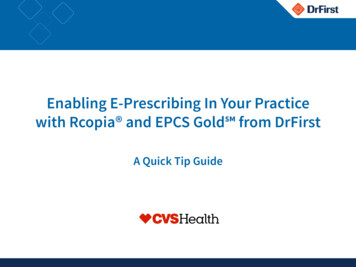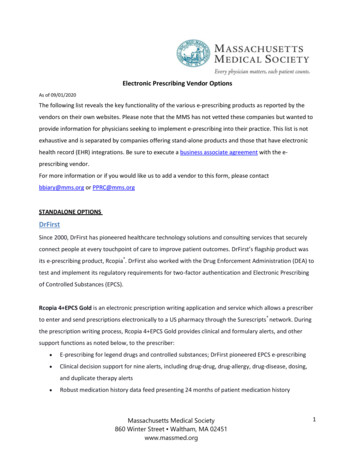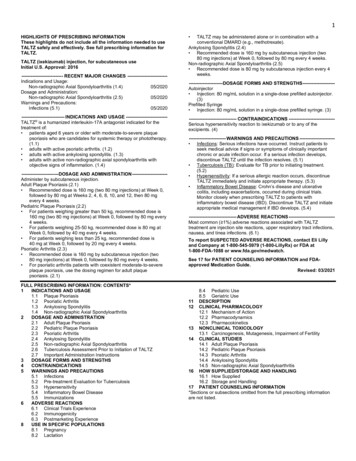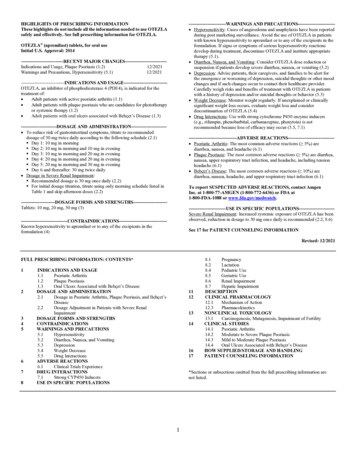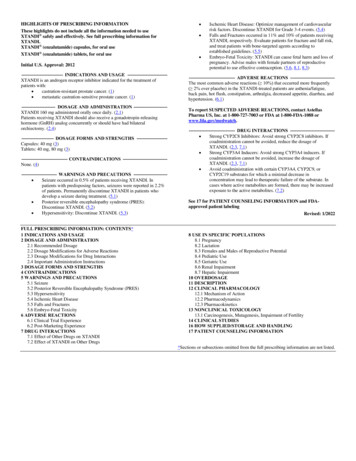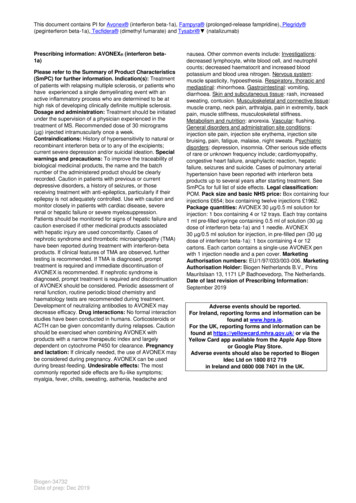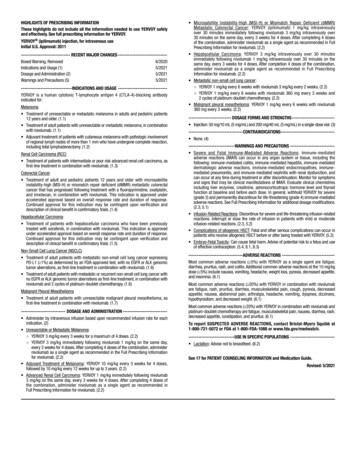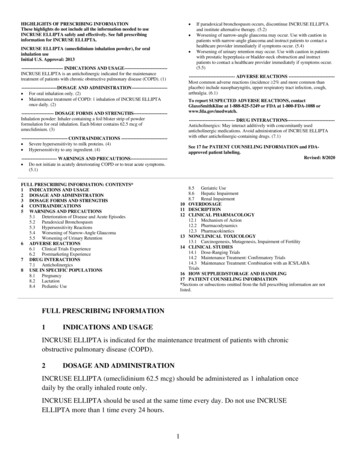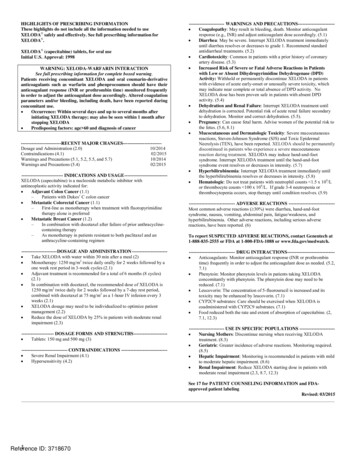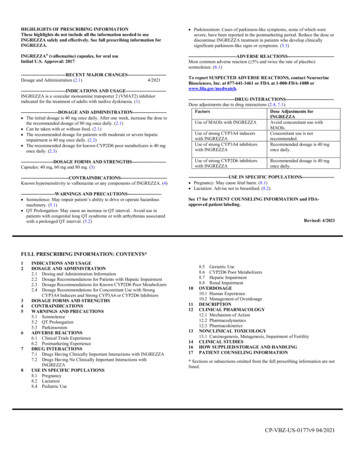
Transcription
HIGHLIGHTS OF PRESCRIBING INFORMATIONThese highlights do not include all the information needed to useINGREZZA safely and effectively. See full prescribing information forINGREZZA. Parkinsonism: Cases of parkinson-like symptoms, some of which weresevere, have been reported in the postmarketing period. Reduce the dose ordiscontinue INGREZZA treatment in patients who develop clinicallysignificant parkinson-like signs or symptoms. (5.3)INGREZZA (valbenazine) capsules, for oral useInitial U.S. Approval: 2017-------------------------------ADVERSE REACTIONS-----------------------------Most common adverse reaction ( 5% and twice the rate of placebo):somnolence. (6.1)-----------------------------RECENT MAJOR CHANGES------------------------Dosage and Administration S AND USAGE-------------------------INGREZZA is a vesicular monoamine transporter 2 (VMAT2) inhibitorindicated for the treatment of adults with tardive dyskinesia. (1)------------------------DOSAGE AND ADMINISTRATION--------------------- The initial dosage is 40 mg once daily. After one week, increase the dose tothe recommended dosage of 80 mg once daily. (2.1) Can be taken with or without food. (2.1) The recommended dosage for patients with moderate or severe hepaticimpairment is 40 mg once daily. (2.2) The recommended dosage for known CYP2D6 poor metabolizers is 40 mgonce daily. (2.3)To report SUSPECTED ADVERSE REACTIONS, contact NeurocrineBiosciences, Inc. at 877-641-3461 or FDA at 1-800-FDA-1088 ---DRUG INTERACTIONS------------------------------Dose adjustments due to drug interactions (2.4, 7.1):FactorsDose Adjustments forINGREZZAUse of MAOIs with INGREZZAAvoid concomitant use withMAOIs.Use of strong CYP3A4 inducersConcomitant use is notwith INGREZZArecommended.Use of strong CYP3A4 inhibitorsRecommended dosage is 40 mgwith INGREZZAonce daily.Use of strong CYP2D6 inhibitorswith INGREZZA---------------------DOSAGE FORMS AND STRENGTHS---------------------Capsules: 40 mg, 60 mg and 80 mg. S-----------------------------Known hypersensitivity to valbenazine or any components of INGREZZA. (4)----------------------WARNINGS AND PRECAUTIONS--------------------- Somnolence: May impair patient’s ability to drive or operate hazardousmachinery. (5.1) QT Prolongation: May cause an increase in QT interval. Avoid use inpatients with congenital long QT syndrome or with arrhythmias associatedwith a prolonged QT interval. (5.2)Recommended dosage is 40 mgonce daily.--------------------------USE IN SPECIFIC POPULATIONS-------------------- Pregnancy: May cause fetal harm. (8.1) Lactation: Advise not to breastfeed. (8.2)See 17 for PATIENT COUNSELING INFORMATION and FDAapproved patient labeling.Revised: 4/2021FULL PRESCRIBING INFORMATION: CONTENTS*12345678INDICATIONS AND USAGEDOSAGE AND ADMINISTRATION2.1 Dosing and Administration Information2.2 Dosage Recommendations for Patients with Hepatic Impairment2.3 Dosage Recommendations for Known CYP2D6 Poor Metabolizers2.4 Dosage Recommendations for Concomitant Use with StrongCYP3A4 Inducers and Strong CYP3A4 or CYP2D6 InhibitorsDOSAGE FORMS AND STRENGTHSCONTRAINDICATIONSWARNINGS AND PRECAUTIONS5.1 Somnolence5.2 QT Prolongation5.3 ParkinsonismADVERSE REACTIONS6.1 Clinical Trials Experience6.2 Postmarketing ExperienceDRUG INTERACTIONS7.1 Drugs Having Clinically Important Interactions with INGREZZA7.2 Drugs Having No Clinically Important Interactions withINGREZZAUSE IN SPECIFIC POPULATIONS8.1 Pregnancy8.2 Lactation8.4 Pediatric Use101112131416178.5 Geriatric Use8.6 CYP2D6 Poor Metabolizers8.7 Hepatic Impairment8.8 Renal ImpairmentOVERDOSAGE10.1 Human Experience10.2 Management of OverdosageDESCRIPTIONCLINICAL PHARMACOLOGY12.1 Mechanism of Action12.2 Pharmacodynamics12.3 PharmacokineticsNONCLINICAL TOXICOLOGY13.1 Carcinogenesis, Mutagenesis, Impairment of FertilityCLINICAL STUDIESHOW SUPPLIED/STORAGE AND HANDLINGPATIENT COUNSELING INFORMATION* Sections or subsections omitted from the full prescribing information are notlisted.CP-VBZ-US-0177v9 04/2021
FULL PRESCRIBING INFORMATION1INDICATIONS AND USAGEINGREZZA is indicated for the treatment of adults with tardive dyskinesia [see Clinical Studies (14)].2DOSAGE AND ADMINISTRATION2.1Dosing and Administration InformationThe initial dosage for INGREZZA is 40 mg once daily. After one week, increase the dose to the recommendeddosage of 80 mg once daily. A dosage of 40 mg or 60 mg once daily may be considered depending on responseand tolerability.Administer INGREZZA orally with or without food [see Clinical Pharmacology (12.3)].2.2Dosage Recommendations for Patients with Hepatic ImpairmentThe recommended dosage for patients with moderate or severe hepatic impairment (Child-Pugh score 7 to 15) isINGREZZA 40 mg once daily [see Use in Specific Populations (8.7), Clinical Pharmacology (12.3)].2.3Dosage Recommendations for Known CYP2D6 Poor MetabolizersThe recommended dosage for known CYP2D6 poor metabolizers is INGREZZA 40 mg once daily [see Use inSpecific Populations (8.6), Clinical Pharmacology (12.3)].2.4Dosage Recommendations for Concomitant Use with Strong CYP3A4 Inducersand Strong CYP3A4 or CYP2D6 InhibitorsCoadministration with Strong CYP3A4 InducersConcomitant use of strong CYP3A4 inducers with INGREZZA is not recommended [see Drug Interactions(7.1)].Coadministration with Strong CYP3A4 InhibitorsThe recommended dosage for patients receiving strong CYP3A4 inhibitors is INGREZZA 40 mg once daily[see Drug Interactions (7.1)].Coadministration with Strong CYP2D6 InhibitorsThe recommended dosage for patients receiving strong CYP2D6 inhibitors is INGREZZA 40 mg once daily[see Drug Interactions (7.1)].3DOSAGE FORMS AND STRENGTHSINGREZZA capsules are available in the following strengths: 40 mg capsules with a white opaque body and purple cap, printed with ‘VBZ’ and ‘40’ in black ink. 60 mg capsules with a dark red opaque body and purple cap, printed with ‘VBZ’ and ‘60’ in black ink. 80 mg capsules with a purple opaque body and cap, printed with ‘VBZ’ and ‘80’ in black ink.2
4CONTRAINDICATIONSINGREZZA is contraindicated in patients with a history of hypersensitivity to valbenazine or any componentsof INGREZZA. Rash, urticaria, and reactions consistent with angioedema (e.g., swelling of the face, lips, andmouth) have been reported [see Adverse Reactions (6.2)].5WARNINGS AND PRECAUTIONS5.1SomnolenceINGREZZA can cause somnolence. Patients should not perform activities requiring mental alertness such asoperating a motor vehicle or operating hazardous machinery until they know how they will be affected byINGREZZA [see Adverse Reactions (6.1)].5.2QT ProlongationINGREZZA may prolong the QT interval, although the degree of QT prolongation is not clinically significant atconcentrations expected with recommended dosing. In patients taking a strong CYP2D6 or CYP3A4 inhibitor,or who are CYP2D6 poor metabolizers, INGREZZA concentrations may be higher and QT prolongationclinically significant [see Clinical Pharmacology (12.2)]. For patients who are CYP2D6 poor metabolizers orare taking a strong CYP2D6 inhibitor, dose reduction may be necessary. For patients taking a strong CYP3A4inhibitor, reduce the dose of INGREZZA to 40 mg once daily [see Dosage and Administration (2.3, 2.4)].INGREZZA should be avoided in patients with congenital long QT syndrome or with arrhythmias associatedwith a prolonged QT interval. For patients at increased risk of a prolonged QT interval, assess the QT intervalbefore increasing the dosage.5.3ParkinsonismINGREZZA may cause parkinsonism in patients with tardive dyskinesia. Parkinsonism has also been observedwith other VMAT2 inhibitors. In the 3 placebo-controlled clinical studies in patients with tardive dyskinesia,the incidence of parkinson-like adverse events was 3% of patients treated with INGREZZA and 1% ofplacebo-treated patients. Postmarketing safety reports have described parkinson-like symptoms, some of whichwere severe and required hospitalization. In most cases, severe parkinsonism occurred within the first twoweeks after starting or increasing the dose of INGREZZA. Associated symptoms have included falls, gaitdisturbances, tremor, drooling and hypokinesia. In cases in which follow-up clinical information was available,parkinson-like symptoms were reported to resolve following discontinuation of INGREZZA therapy. Reducethe dose or discontinue INGREZZA treatment in patients who develop clinically significant parkinson-likesigns or symptoms.6ADVERSE REACTIONSThe following adverse reactions are discussed in more detail in other sections of the labeling: Hypersensitivity [see Contraindications (4)] Somnolence [see Warnings and Precautions (5.1)] QT Prolongation [see Warnings and Precautions (5.2)] Parkinsonism [see Warnings and Precautions (5.3)]3
6.1Clinical Trials ExperienceBecause clinical trials are conducted under widely varying conditions, adverse reaction rates observed in theclinical trials of a drug cannot be directly compared to rates in the clinical trials of another drug and may notreflect the rates observed in practice.Variable and Fixed Dose Placebo-Controlled Trial ExperienceThe safety of INGREZZA was evaluated in 3 placebo-controlled studies, each 6 weeks in duration (fixed dose,dose escalation, dose reduction), including 445 patients. Patients were 26 to 84 years of age with moderate tosevere tardive dyskinesia and had concurrent diagnoses of mood disorder (27%) or schizophrenia/schizoaffective disorder (72%). The mean age was 56 years. Patients were 57% Caucasian, 39% AfricanAmerican, and 4% other. With respect to ethnicity, 28% were Hispanic or Latino. All subjects continuedprevious stable regimens of antipsychotics; 85% and 27% of subjects, respectively, were taking atypical andtypical antipsychotic medications at study entry.Adverse Reactions Leading to Discontinuation of TreatmentA total of 3% of INGREZZA treated patients and 2% of placebo-treated patients discontinued because ofadverse reactions.Common Adverse ReactionsAdverse reactions that occurred in the 3 placebo-controlled studies at an incidence of 2% and greater thanplacebo are presented in Table 1.Table 1:Adverse Reactions in 3 Placebo-Controlled Studies of 6-week Treatment DurationReported at 2% and PlaceboINGREZZA(n 262) (%)Placebo(n 183) (%)10.9%4.2%5.4%4.9%Balance disorders/fall(fall, gait disturbance, dizziness, balance ia, restlessness)Gastrointestinal culoskeletal DisordersArthralgia2.3%0.5%Adverse Reaction1General DisordersSomnolence(somnolence, fatigue, sedation)Nervous System DisordersAnticholinergic effects(dry mouth, constipation, disturbance in attention, visionblurred, urinary retention)1Within each adverse reaction category, the observed adverse reactions are listed in order of decreasing frequency.Other Adverse Reactions Observed During the Premarketing Evaluation of INGREZZA4
Other adverse reactions of 1% incidence and greater than placebo are shown below. The following list doesnot include adverse reactions: 1) already listed in previous tables or elsewhere in the labeling, 2) for which adrug cause was remote, 3) which were so general as to be uninformative, 4) which were not considered to haveclinically significant implications, or 5) which occurred at a rate equal to or less than placebo.Endocrine Disorders: blood glucose increasedGeneral Disorders: weight increasedInfectious Disorders: respiratory infectionsNeurologic Disorders: drooling, dyskinesia, extrapyramidal symptoms (non-akathisia)Psychiatric Disorders: anxiety, insomniaDuring controlled trials, there was a dose-related increase in prolactin. Additionally, there was a dose-relatedincrease in alkaline phosphatase and bilirubin, suggesting a potential risk for cholestasis.6.2Postmarketing ExperienceThe following adverse reactions have been identified during post-approval use of INGREZZA that are notincluded in other sections of labeling. Because these reactions are reported voluntarily from a population ofuncertain size, it is not always possible to reliably estimate their frequency or establish a causal relationship todrug exposure.Immune System Disorders: hypersensitivity reactions (including allergic dermatitis, angioedema, pruritis, andurticaria)Skin and Subcutaneous Tissue Disorders: rash7DRUG INTERACTIONS7.1Drugs Having Clinically Important Interactions with INGREZZATable 2:Clinically Significant Drug Interactions with INGREZZAMonoamine Oxidase Inhibitors (MAOIs)Clinical Implication:Concomitant use of INGREZZA with MAOIs may increase theconcentration of monoamine neurotransmitters in synapses, potentiallyleading to increased risk of adverse reactions such as serotonin syndrome,or attenuated treatment effect of INGREZZA.Prevention or Management:Avoid concomitant use of INGREZZA with MAOIs.Examples:isocarboxazid, phenelzine, selegilineStrong CYP3A4 InhibitorsClinical Implication:Concomitant use of INGREZZA with strong CYP3A4 inhibitors increasedthe exposure (Cmax and AUC) to valbenazine and its active metabolitecompared with the use of INGREZZA alone [see Clinical Pharmacology(12.3)]. Increased exposure of valbenazine and its active metabolite mayincrease the risk of exposure-related adverse reactions [see Warnings andPrecautions (5.2)].Prevention or Management:Reduce INGREZZA dose when INGREZZA is coadministered with astrong CYP3A4 inhibitor [see Dosage and Administration (2.4)].Examples:itraconazole, ketoconazole, clarithromycin5
Strong CYP2D6 InhibitorsClinical Implication:Prevention or Management:Examples:Strong CYP3A4 InducersClinical Implication:Prevention or Management:Examples:DigoxinClinical Implication:Prevention or Management:17.2Concomitant use of INGREZZA with strong CYP2D6 inhibitors increasedthe exposure (Cmax and AUC) to valbenazine’s active metabolite comparedwith the use of INGREZZA alone [see Clinical Pharmacology (12.3)].Increased exposure of active metabolite may increase the risk ofexposure-related adverse reactions [see Warnings and Precautions (5.2)].Reduce INGREZZA dose when INGREZZA is coadministered with astrong CYP2D6 inhibitor [see Dosage and Administration (2.4)].paroxetine, fluoxetine, quinidineConcomitant use of INGREZZA with a strong CYP3A4 inducer decreasedthe exposure of valbenazine and its active metabolite compared to the useof INGREZZA alone. Reduced exposure of valbenazine and its activemetabolite may reduce efficacy [see Clinical Pharmacology (12.3)].Concomitant use of strong CYP3A4 inducers with INGREZZA is notrecommended [see Dosage and Administration (2.3)].rifampin, carbamazepine, phenytoin, St. John’s wort1Concomitant use of INGREZZA with digoxin increased digoxin levelsbecause of inhibition of intestinal P-glycoprotein (P-gp) [see ClinicalPharmacology (12.3)].Digoxin concentrations should be monitored when co-administeringINGREZZA with digoxin. Increased digoxin exposure may increase therisk of exposure-related adverse reactions. Dosage adjustment of digoxinmay be necessary.The induction potency of St. John’s wort may vary widely based on preparation.Drugs Having No Clinically Important Interactions with INGREZZADosage adjustment for INGREZZA is not necessary when used in combination with substrates of CYP1A2,CYP2B6, CYP2C8, CYP2C9, CYP2C19, CYP2E1, or CYP3A4/5 based on in vitro study results.8USE IN SPECIFIC POPULATIONS8.1PregnancyRisk SummaryThe limited available data on INGREZZA use in pregnant women are insufficient to inform a drug-associatedrisk. In animal reproductive studies, no malformations were observed when valbenazine was administeredorally to rats and rabbits during the period of organogenesis at doses up to 1.8 or 24 times, respectively, themaximum recommended human dose (MRHD) of 80 mg/day based on mg/m2 body surface area. However,administration of valbenazine to pregnant rats during organogenesis through lactation produced an increase inthe number of stillborn pups and postnatal pup mortalities at doses 1 times the MRHD based on mg/m2 [seeData]. Advise a pregnant woman of the potential risk to a fetus.The estimated background risk of major birth defects and miscarriage for the indicated population is unknown.All pregnancies have a background risk of birth defect, loss, or other adverse outcomes. The background risk ofmajor birth defects and miscarriage in the U.S. general population is 2 to 4% and 15 to 20% of clinicallyrecognized pregnancies, respectively.6
DataAnimal DataValbenazine was administered orally to pregnant rats during the period of organogenesis at 1, 5, and15 mg/kg/day, which are approximately 0.1, 0.6, and 2 times the MRHD of 80 mg/day based on mg/m2 bodysurface area. Valbenazine produced a significant decrease in maternal body weight gain at 0.6 and 2 times theMRHD of 80 mg/day based on mg/m2. No adverse embryo fetal effects were produced when valbenazine wasadministered at doses up to 2 times the MRHD of 80 mg/day based on mg/m2.Valbenazine was administered orally to pregnant rabbits during the period of organogenesis at 20, 50, and 100mg/kg/day, which are approximately 5, 12, and 24 times the MRHD of 80 mg/day based on mg/m2. Nomalformations were observed at doses up to 24 times the MRHD of 80 mg/day based on mg/m2. However,valbenazine produced a delay in fetal development (decreased fetal weights and delayed ossification) at 24times the MRHD of 80 mg/day based on mg/m2, likely secondary to maternal toxicity (decreased food intakeand loss in body weight).Valbenazine was administered orally to pregnant rats during the period of organogenesis through lactation (day7 of gestation through day 20 postpartum) at 1, 3, and 10 mg/kg/day, which are approximately 0.1, 0.4, and 1.2times the MRHD of 80 mg/day based on mg/m2. Valbenazine produced an increase in the incidence ofstillbirths and postnatal pup mortality at 0.4 and 1.2 times the MRHD of 80 mg/day based on mg/m2.Valbenazine did not affect neurobehavioral function including learning and memory and had no effect on sexualmaturation at doses 1 times the MRHD of 80 mg/day based on mg/m2 (because of death in the majority of thehigh dose group (1.2 times the MRHD), these parameters were not assessed in this group).8.2LactationRisk SummaryThere is no information regarding the presence of valbenazine or its metabolites in human milk, the effects onthe breastfed infant, or the effects on milk production. Valbenazine and its metabolites have been detected in ratmilk at concentrations higher than in plasma following oral administration of valbenazine at doses 0.1 to 1.2times the MRHD based on mg/m2. Based on animal findings of increased perinatal mortality in exposed fetusesand pups, advise a woman not to breastfeed during treatment with INGREZZA and for 5 days after the finaldose.8.4Pediatric UseSafety and effectiveness of INGREZZA have not been established in pediatric patients.8.5Geriatric UseNo dose adjustment is required for elderly patients. In 3 randomized, placebo-controlled studies of INGREZZA,16% were 65 years and older. The safety and effectiveness were similar in patients older than 65 yearscompared to younger patients.8.6CYP2D6 Poor MetabolizersDosage reduction of INGREZZA is recommended for known CYP2D6 poor metabolizers [see Dosage andAdministration (2.3)]. Increased exposure (Cmax and AUC) to valbenazine’s active metabolite is anticipated inCYP2D6 poor metabolizers. Increased exposure of active metabolite may increase the risk of exposure-relatedadverse reactions [see Clinical Pharmacology (12.3)].7
8.7Hepatic ImpairmentDosage reduction of INGREZZA is recommended for patients with moderate or severe hepatic impairment [seeDosage and Administration (2.2)]. Patients with moderate to severe hepatic impairment (Child-Pugh score 7 to15) had higher exposure of valbenazine and its active metabolite than patients with normal hepatic function [seeClinical Pharmacology (12.3)].8.8Renal ImpairmentDosage adjustment is not necessary for patients with mild, moderate, or severe renal impairment. INGREZZAdoes not undergo primary renal clearance [see Clinical Pharmacology (12.3)].10OVERDOSAGE10.1Human ExperienceThe pre-marketing clinical trials involving INGREZZA in approximately 850 subjects do not provideinformation regarding symptoms with overdose.10.2Management of OverdosageNo specific antidotes for INGREZZA are known. In managing overdose, provide supportive care, includingclose medical supervision and monitoring, and consider the possibility of multiple drug involvement. If anoverdose occurs, consult a Certified Poison Control Center (1-800-222-1222 or www.poison.org).11DESCRIPTIONINGREZZA contains valbenazine, a vesicular monoamine transporter 2 (VMAT2) inhibitor, present asvalbenazine tosylate salt, with the chemical name, L-Valine, -3-(2-methylpropyl)-2H-benzo[a]quinolizin-2-yl ester, 4-methylbenzenesulfonate (1:2). Valbenazinetosylate is slightly soluble in water. Its molecular formula is C38H54N2O10S2, and its molecular weight is762.97 g/mol (ditosylate salt) with the following structure:OO2TsOH11b NH2O3ONH2The molecular formula of valbenazine free base is C24H38N2O4 and its molecular weight is 418.57.INGREZZA capsules are intended for oral administration only. Each capsule contains 73 mg, 109 mg or 146mg of valbenazine tosylate equivalent to 40 mg, 60 mg or 80 mg of valbenazine free base, respectively. Thecapsules contain the following inactive ingredients: hypromellose, isomalt, magnesium stearate, pregelatinizedstarch, and silicified microcrystalline cellulose. The capsule shells contain candurin silver fine, FD&C Blue#1,FD&C Red#40, and gelatin.8
12CLINICAL PHARMACOLOGY12.1Mechanism of ActionThe mechanism of action of valbenazine in the treatment of tardive dyskinesia is unclear, but is thought to bemediated through the reversible inhibition of vesicular monoamine transporter 2 (VMAT2), a transporter thatregulates monoamine uptake from the cytoplasm to the synaptic vesicle for storage and release.12.2PharmacodynamicsValbenazine inhibits human VMAT2 (Ki 150 nM) with no appreciable binding affinity for VMAT1(Ki 10 µM). Valbenazine is converted to the active metabolite [ ]-α-dihydrotetrabenazine ([ ]-α-HTBZ).[ ]-α-HTBZ also binds with relatively high affinity to human VMAT2 (Ki 3 nM). Valbenazine and [ ]-αHTBZ have no appreciable binding affinity (Ki 5000 nM) for dopaminergic (including D2), serotonergic(including 5HT2B), adrenergic, histaminergic or muscarinic receptors.Cardiac ElectrophysiologyINGREZZA may cause an increase in the corrected QT interval in patients who are CYP2D6 poor metabolizersor who are taking a strong CYP2D6 or CYP3A4 inhibitor. An exposure-response analysis of clinical data fromtwo healthy volunteer studies revealed increased QTc interval with higher plasma concentrations of the activemetabolite. Based on this model, patients taking an INGREZZA 60 mg or 80 mg dose with increased exposureto the metabolite (e.g., being a CYP2D6 poor metabolizer) may have a mean (upper bound of double-sided 90%CI) QT prolongation of 9.6 (12.0) msec or 11.7 (14.7) msec, respectively as compared to otherwise healthyvolunteers given INGREZZA, who had a respective mean (upper bound of double-sided 90% CI) QTprolongation of 5.3 (6.7) msec or 6.7 (8.4) msec [see Warnings and Precautions (5.2)].12.3PharmacokineticsValbenazine and its active metabolite ([ ]-α-HTBZ) demonstrate approximate proportional increases for thearea under the plasma concentration versus time curve (AUC) and maximum plasma concentration (Cmax) aftersingle oral doses from 40 mg to 300 mg (i.e., 50% to 375% of the recommended treatment dose).AbsorptionFollowing oral administration, the time to reach maximum valbenazine plasma concentration (tmax) ranges from0.5 to 1.0 hours. Valbenazine reaches steady state plasma concentrations within 1 week. The absolute oralbioavailability of valbenazine is approximately 49%. [ ]-α-HTBZ gradually forms and reaches Cmax 4 to8 hours after administration of INGREZZA.Ingestion of a high-fat meal decreases valbenazine Cmax by approximately 47% and AUC by approximately13%. [ ]-α-HTBZ Cmax and AUC are unaffected.DistributionThe plasma protein binding of valbenazine and [ ]-α-HTBZ are greater than 99% and approximately 64%,respectively. The mean steady state volume of distribution of valbenazine is 92 L.Nonclinical data in Long-Evans rats show that valbenazine can bind to melanin-containing structures of the eyesuch as the uveal tract. The relevance of this observation to clinical use of INGREZZA is unknown.EliminationValbenazine has a mean total plasma systemic clearance value of 7.2 L/hr. Valbenazine and [ ]-α-HTBZ havehalf-lives of 15 to 22 hours.9
MetabolismValbenazine is extensively metabolized after oral administration by hydrolysis of the valine ester to formthe active metabolite ([ ]-α-HTBZ) and by oxidative metabolism, primarily by CYP3A4/5, to form monooxidized valbenazine and other minor metabolites. [ ]-α-HTBZ appears to be further metabolized in part byCYP2D6.The results of in vitro studies suggest that valbenazine and [ ]-α-HTBZ are unlikely to inhibit CYP1A2,CYP2B6, CYP2C8, CYP2C9, CYP2C19, CYP2E1 or CYP3A4/5, or induce CYP1A2, CYP2B6 orCYP3A4/5 at clinically relevant concentrations.The results of in vitro studies suggest that valbenazine and [ ]-α-HTBZ are unlikely to inhibit thetransporters (BCRP, OAT1, OAT3, OCT2, OATP1B1, or OATP1B3) at clinically relevant concentrations.ExcretionFollowing the administration of a single 50-mg oral dose of radiolabeled C-valbenazine (i.e., 63% of therecommended treatment dose), approximately 60% and 30% of the administered radioactivity wasrecovered in the urine and feces, respectively. Less than 2% was excreted as unchanged valbenazine or[ ]-α-HTBZ in either urine or feces.Studies in Specific PopulationsExposures of valbenazine in patients with hepatic and severe renal impairment are summarized in Figure 1.Figure 1:Effects of Hepatic and Severe Renal Impairment on Valbenazine PharmacokineticsFold Change and 90% Confidence icValbenazine[ UCinf[ infSevereRenal[ ]-α-HTBZValbenazine[ e relative to referenceAUCinf area under the plasma concentration versus time curve from 0 hours extrapolated to infinity[ ]-α-HTBZ [ ]-α-dihydrotetrabenazine (active metabolite)Drug Interaction StudiesThe effects of paroxetine, ketoconazole and rifampin on the exposure of valbenazine are summarized inFigure 2.10
Figure 2:Effects of Strong CYP2D6 and CYP3A4 Inhibitors and CYP3A4 Inducers on ValbenazinePharmacokineticsFold Change and 90% confidence intervalsStrong CYP2D6 Inhibitor:ParoxetineCmaxValbenazine AUCinfCmax[ ]-α-HTBZ AUCinfStrong CYP3A4 Inducer:RifampinValbenazineCmaxAUCinfCmax[ ]-α-HTBZ AUCinfStrong CYP3A4 Inhibitor:KetoconazoleValbenazineCmaxAUCinfCmax[ ]-α-HTBZ AUCinf0.250.512Change relative to reference (without interacting drug)AUCinf area under the plasma concentration versus time curve from 0 hours extrapolated to infinity[ ]-α-HTBZ [ ]-α-dihydrotetrabenazine (active metabolite)The effects of valbenazine on the exposure of other coadministered drugs are summarized in Figure 3.Figure 3:Effects of Valbenazine on Pharmacokinetics of Other DrugsFold Change and 90% confidence intervalsCYP3A4 Substrate:MidazolamCmaxAUCinfP-gp Substrate:DigoxinCmaxAUCinf0.5124Change relative to referenceAUCinf area under the plasma concentration versus time curve from 0 hours extrapolated to infinity11
13NONCLINICAL TOXICOLOGY13.1Carcinogenesis, Mutagenesis, Impairment of FertilityCarcinogenesisValbenazine did not increase tumors in rats treated orally for 91 weeks at 0.5, 1, and 2 mg/kg/day. These dosesare 1 times (0.06, 0.1, and 0.24 times, respectively) the MRHD of 80 mg/day based on mg/m2.Valbenazine did not increase tumors in hemizygous Tg.rasH2 mice treated orally for 26 weeks at 10, 30 and 75mg/kg/day, which are 0.6, 1.9 and 4.6 times the MRHD of 80 mg/day based on mg/m2.MutagenesisValbenazine was not mutagenic in the in vitro bacterial reverse mutation test (Ames) or clastogenic in the invitro mammalian chromosomal aberrations assay in human peripheral blood lymphocytes or in the in vivo ratbone marrow micronucleus assay.Impairment of FertilityIn a fertility study, rats were treated orally with valbenazine at 1, 3, and 10 mg/kg/day prior to mating andthrough mating, for a minimum of 10 weeks (males) or through Day 7 of gestation (females). These doses are0.1, 0.4, and 1.2 times the MRHD of 80 mg/day based on mg/m2, respectively. Valbenazine delayed mating inboth sexes, which led to lower number of pregnancies and disrupted estrous cyclicity at the high dose, 1.2 timesthe MRHD of 80 mg/day based on mg/m2. Valbenazine had no effects on sperm parameters (motility, count,density) or on uterine parameters (corpora lutea, number of implants, viable implants, pre-implantation loss,early resorptions and post-implantation loss) at any dose.14CLINICAL STUDIESA randomized, double-blind, placebo-controlled trial of INGREZZA was conducted in patients with moderateto severe tardive dyskinesia as determined by clinical observation. Patients had underlying schizophrenia,schizoaffective disorder, or a mood disorder. Individuals at significant risk for suicidal or violent behavior andindividuals with unstable psychiatric symptoms were excluded.The Abnormal Involuntary Movement Scale (AIMS) was the primary efficacy measure for the assessment oftardive dyskinesia severity. The AIMS is a 12-item scale; items 1 to 7 assess the severity of involuntarymovements across body regions and these items were used in this study. Each of the 7 it
Adverse reactions that occurred in the 3 placebo-controlled studies at an incidence of 2% and greater than placebo are presented in Table 1. Table 1: Adverse Reactions in 3 Placebo-Controlled Studies of 6-week Treatment Duration . Reported at 2% and Placebo. Adverse Reaction. 1. INGREZZA (n 262) (%) Placebo (n 183) (%) General Disorders .

